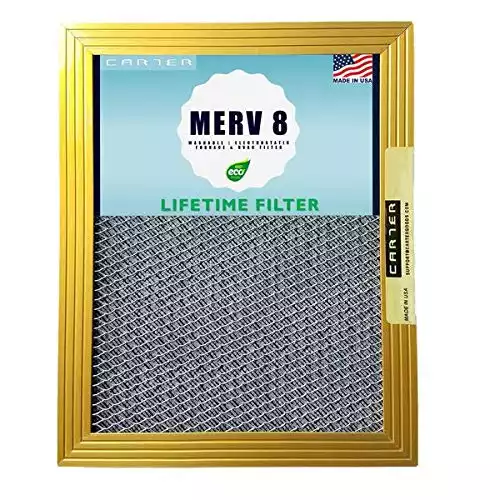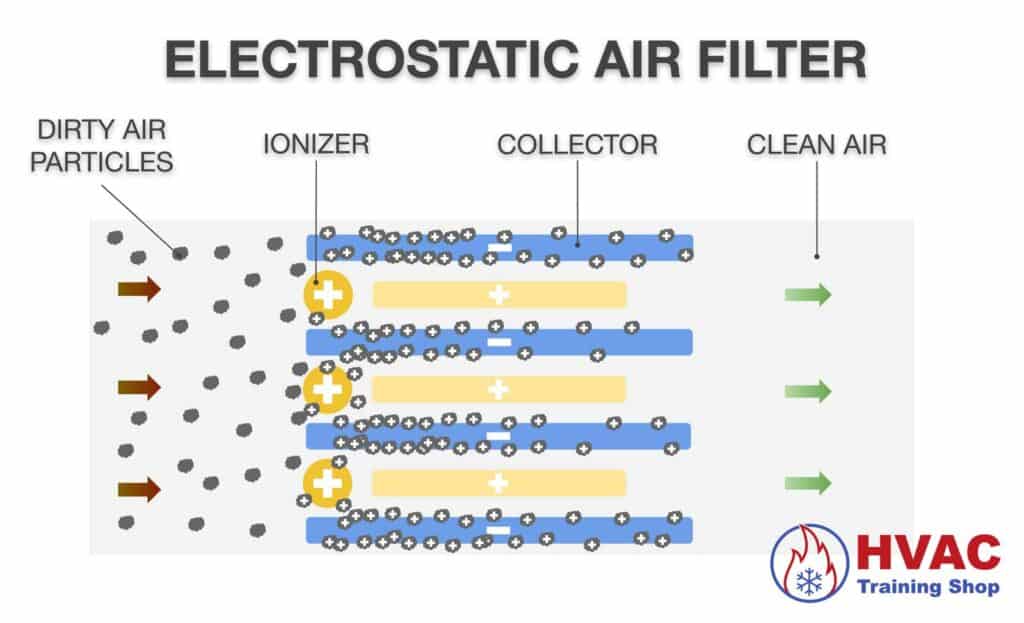HVAC Training Shop is reader-supported. As an Amazon Associate, I earn from qualifying purchases.
When selecting the type of air filter that you use in your home’s HVAC system, there are two main types of filters: disposable air filters, and electrostatic air filters. While most people use the former, there are a few advantages to using electrostatic air filters.
In this article, I’ll discuss what electrostatic air filters are, how they work, and in what situation you should use them in your home’s AC or heating system.
What are electrostatic air filters?
Electrostatic air filters are air filters that filter out particles by means of static electricity. If you have seen washable, metal air filters, then those are electrostatic air filters.
In fact, the terms “washable air filter” and “electrostatic air filter” have become interchangeable since most electrostatic air filters are the washable, metal type. For the purposes of this article, I’m going to be discussing these types of filters.
However, it should be pointed out that some disposable pleated air filters also use electrostatic attraction to filter out particles. So pleated filters are, to some extent, electrostatic air filters as well (although their primary means of filtration is mechanical and not electrostatic).
This electrostatic air filter has self-charging filter media—so it can be washed and reused over and over again.
How do electrostatic air filters work?
Electrostatic air filters clean air by means of static electricity. If you have ever rubbed your socks on the carpet then you’re already familiar with static electricity and how powerful it can be.
The difference in charges of particles is what causes static electricity. Electrostatic air filters use this phenomenon to remove particles from the air by attracting the particles to the air filter.
When air flows through an electrostatic air filter, electrical charges are generated in the filter’s media that allows the filter to attract particles:
- As particles that are suspended in the air stream flow through the air filter, they first pass through a section that charges the particles. This charging is called ionization. Some filters have multiple layers that increases the attraction of the particles.
- Next, the charged particles pass through a section in the filter that has an opposite charge to the particles. As the charged particles pass through the filtering section, they attract towards the filter media due to their opposite charge. This process is called collection since the particles are collected in the filter.
- Some air filters have multiple layers, so the process can repeat several times, filtering out additional particles each pass.
Electrostatic air filter advantages and disadvantages
Using an electrostatic air filter has some advantages:
- Lower cost. Even though electrostatic air filters cost more than disposable air filters, you’ll end up saving money in the long run. This is because electrostatic air filters can be washed and reused over and over again.
- Affinity for small particles. Since electrostatic air filters use static electricity to capture particles, they are able to capture small microscopic particles that disposable pleated filters would normally miss.
Like anything else, using an electrostatic air filter also has some disadvantages:
- Limited efficiency. Electrostatic air filters get less efficient when they get dirty. This is in contrast to pleated filters, which get more efficient the dirtier they get.
- Less effective with increased airflow. At higher airflow velocities, electrostatic air filters are not very great at filtering out particles. This is because they dont have much mechanical means to capture particles, so the electrostatically-attracted particles can be literally ripped off of the filter’s collector if airflow velocity is high enough.
How to clean an electrostatic air filter
Its no secret that dirty air filters can cause issues in your HVAC system. Reduced airflow and increased energy usage are some of the impacts that a dirty filter will cause.
While pleated filters actually get more efficient as they collect particles, electrostatic filters actually get less efficient. This is because the attractiveness of the air filter’s collector gets weaker and weaker as particles build up on the filter media. Therefore, there is absolutely no benefit to using a dirty electrostatic air filter.
To clean your electrostatic air filter, follow these steps:
- Turn off your HVAC unit. You don’t want to leave your AC or furnace running without a filter. Some people keep a spare filter available to use in their HVAC unit while they are cleaning the main filter.
- Carefully remove your electrostatic air filter from the filter rack. The filter rack is usually located in the return duct of the air handler. The air filter can sometimes be located at the return air intake inside your home. It is is a good idea to put the filter in a trash bag to prevent any dust from falling off the filter inside your home.
- Using a water hose, spray the filter’s clean side with a stream of water. You’ll want to spray water in the direction opposite of the airflow arrow. This is a process known as backwashing. Continue spraying the air filter, ensuring that the entire area is sprayed to dislodge all dust and particles.
Note: Using a sink or bathtub to clean out your electrostatic air filter is not sufficient. This is because there is not enough water pressure to sufficiently dislodge and remove the particles from the filter. - At this point, you’ll need to assess if a stronger cleaning is needed. It’s usually a good idea to use a cleaning solution a few times a year to deep clean your electrostatic air filter.
- Ensure that your filter is completely rinsed out – clean, clear water should be flowing out of it when you spray it.
- Leave your filter outside to let it dry. Prop it up against an object such as the side of your home and ensure that the drain holes are on the bottom to allow excess water to drain out.
- Wait for 30 to 60 minutes (or as long as it takes) for the filter to completely dry. It is important that the filter is completely dry before reinstalling it into your air handler, so give it some additional time to dry out if needed.
- Reinstall the air filter into your air handler. The air filter should have an arrow on its side that indicates the direction of airflow. This is very important. The arrow should point towards the blower. If the filter is installed in your return register, then the arrow should point towards the wall or ceiling.
This electrostatic air filter cleaning spray is specially formulated to clean off soil, grime, and other contaminants while maintaining the filter’s effectiveness.
How often should you clean your electrostatic air filter?
Cleaning your electrostatic air filter is essential to maintaining its effectiveness. As the filter is used, particles build up on its collector and reduce the filter’s effectiveness.
To maintain peak filter performance, I recommend cleaning your electrostatic filter at least once a month. This ensures that the filter doesn’t lose its efficiency, and continues to filter out as many particles as it can.
Electrostatic air filter MERV ratings
While some electrostatic air filters are MERV-rated, others are not. That being said, most electrostatic air filters have similar efficiency to air filters on the lower end of the MERV scale- around MERV 4 to MERV 5.
However, if you need a specific MERV rating for your air filter, then a washable electrostatic air filter may not be the best option. This is because electrostatic filters lose their filtration efficiency as they get dirty. So that means that the MERV rating of an electrostatic filter will drop as it collects more particles. Another good reason to keep your electrostatic filter clean!







I was told by my HVAC tech that the electrostatic filter reduces the performance of my AC. The filter reduces the airfow and makes the AC work harder. The filter can shorten the life my AC. ??
Hi Preston,
It depends on the exact model of electrostatic air filter. Some of them may reduce more airflow than a standard pleated filter – in that case, the electrostatic filter could shorten the life of your AC.
Hope this helps,
-Trey
Good morning I have a electrostatic air filter made by carrier the home I purchased a year ago has a brand new furnace made by Duqcane I was having some trouble here in November I called in a technician he explained to me that the air filter was dirty and needed replacing also he showed me that there’s electrical wires that are disconnected. So my question is do electrostatic air filters need to have electricity connected to it to work properly? Should I replace them. Thanks
Hi Clarence,
That is an electronic air filter – the working principal is the same as an electrostatic air filter, but it requires electricity to generate its charge. Like electrostatic air filters, electronic air filters need to be cleaned regularly to maintain their effectiveness.
Hope this helps,
-Trey